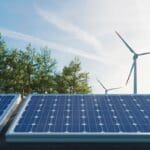At the ARC Industry Leadership Forum in February, I had the opportunity to sit down with Rick Rys, Director of Consulting at ARC Advisory Group, to discuss the electric power supply chain. I asked Rick to give some deeper insights on a few key points. First, what are the overall supply chain issues make power greener? Second, what are the driving forces for this transition to renewable and how quickly is it happening? Third, what is the role of nuclear power in the future? And finally, how can the grid work and stay reliable with wind and solar, when the wind does not blow, and the sun does not shine? Below are the key points from our discussion.
Electric Power Supply Chain Issues
Over the past decades In the US, we have seen coal drop from about 50 percent of our power to 10-15 percent, mostly being displaced by natural gas. In the past 5 years we have seen solar, wind, and batteries start to displace natural gas. This is changing the power mix that grid operators must manage. In the US the power demand is rising slowly, but Asia is the big growth area. The grid cannot add power fast enough to keep up with new demands from electric vehicles, heat pumps, and industrial electrification.
Renewable Driving Forces
There are many factors at play. The cost of solar, wind, and batteries have declined sharply over the past decade and continue to drop, while the cost of coal has increased, and gas power is relatively flat. So, there are no new coal power plants being built but there are still some new gas power plants being built, however adding CCUS to a gas plant makes them uncompetitive in the current utility markets. That could change in the future. While onshore wind power is the largest renewable, solar is now the leading source of new electric power followed by wind (mostly onshore), which is followed by new gas power plants. New power additions have exceeded the power retirements of coal plants. There are large variations by state with Wyoming, West Virginia, and Kentucky power dominated by coal, but South Dakota takes the crown for renewable power from wind, while Washington, New York, Vermont, and California are the leaders with carbon free power mostly due to hydro and/or nuclear.
The Role of Nuclear Power in the Electric Power Supply Chain
There are about 50 companies developing new nuclear fission reactors and more than 40 companies developing nuclear fusion power. There are several new fission nuclear designs that follow conventional PWR/BWR/Candu technology and new SMR’s and several new advanced reactors involving molten salt, sodium cooling, and advanced fuel cycles with different moderators, high enriched uranium, and even thorium-based fuels. Some of these new reactors are “walk away safe” and use passive cooling methods and many are trying to build them as modules in a factory to keep costs down. The bottom line is nuclear remains expensive and time consuming to build. There are a handful of new nuclear plants being built outside of the US and a nuclear renaissance is at least 10 years away, as they need time to prove these new technologies are as safe as they seem. We have only the Vogtle 3 recently started and Vogle 4 imminent, but huge price and schedule overruns making utilities shy about buying into nuclear power. Nuclear will not save the climate which needs action in the short term. That can come from reduced CO2 and methane emissions.
Grid Reliability
There is no choice about this as wind and solar are the main new sources of power over the next 10 years and there are solutions, but cost will be sort out the winners and losers. FERC order 2023 is aimed are reducing the interconnection queue which will speed up renewable connections, and microgrids are growing fast. Nuclear and hydro do not go away, and they can provide useful base load support at about 20 percent of grid power. I’ve seen how ISO-NE is addressing this issue and there are a range of solutions and scenarios with the ability to change strategies as needed. First is to understand the gaps that will need to be filled by looking at statistics for renewable power production, including behind the meter like rooftop solar or community microgrids. New markets can play a huge role to incentivize the right investments to fill the gaps and fund transmission upgrades. Ideally the US should have a single highly interconnected grid, but that does not seem to be in the cards now. The wholesale market is not the solution and that new markets need to be created in each RTO/ISO region.
Scheduled EV charging and time of day pricing will change the utility business model, so people will use power when it is cheap and available. We have various energy storage technologies like pumped hydro and lithium batteries, but many other energy storage technologies that are looking to improve on the high cost of lithium batteries and work over longer periods. New transmission lines add stability and are needed for offshore wind which is a bit slow now but will grow fast once we learn how. Offshore wind has a big advantage for steadier power with capacity factors over 50%. Natural gas with CCUS and Hydrogen are also known solutions, but they are expensive and must compete in this complex situation. Some suggest overbuilding wind and solar and suffering some curtailments will reduce the size of the power gaps at lower costs than adding storage. This will create times when power is free or even negative and there will be creative ways to put low-cost power to use. In the end, long term power costs will be lower.
The post The Electric Power Supply Chain appeared first on Logistics Viewpoints.
